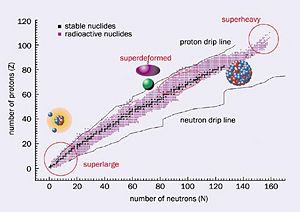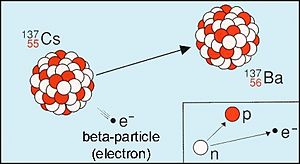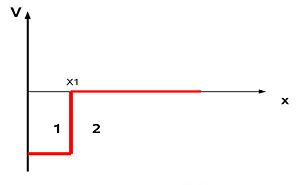4th Week: Decays, Tunneling and Cross Sections
Nuclear Radiation
When looking at the table of nuclides it is obvious that the valley of stability is only a small percentage of all known nuclei. So most nuclei are considered unstable. To become stable these nuclides emit ionizing particles and radiation, resulting in a loss of energy from the original nuclei. This process is called radioactive decay.
Alpha Decay and Fission
Alpha decay is the transformation of a parent nucleus to a daughter nucleus through the emission of a helium nucleus. This decay is usually seen in heavier elements with too many protons. This causes excessive repulsion due to the coulomb force. In an attempt to get rid of this excessive repulsion the nucleus emits an alpha particle.
Alpha decay and nuclear fission are both considered to be a two body disintegration. In the case of an alpha decay, the daughter nucleus is at rest and most of the released energy is carried away by the alpha particle. For fission the energy is distributed between the two daughter nuclei.
Beta Decay
There are three types of beta decays, -decay, -decay, and electron capture. All three of these decays can be characterized by and .
The first one, decay, occurs when a nucleus with an over abundance of neutrons transforms to a more stable nucleus by emitting an electron. This process can be denoted as:
From electric-charge conservation, the proton number in such decays is increased by one unit.
Likewise, a -decay occurs when a proton-rich nucleus emits a positron, therefore reducing the nuclear charge by one.
The final case, electron capture, is similar to -decay because it is another way for a proton -rich nucleus to reduce its nuclear charge by the capture of an electron
Gamma Decay
When a nucleus changes its state from the higher energetic state to the lower energetic state an electromagnetic radiation will be emitted in terms of high energy photons. This process is known as a gamma decay, and the decayed photon is called gamma-particle. In this case both the parent and daughter nuclei are the same, as the number of protons and neutrons do not change.
Transition probabilities through the potential barriers
The transition probability in general is given by
where is quantum-mechanical flux
Using the so called WKB approximation it can be calculated through the following formula
where and are turning points, is the potential.
Coulomb barrier
This is the energy barrier due to electrostatic interaction that two nuclei need to overcome so they can get close enough to undergo nuclear fusion. This energy barrier is given by the electrostatic potential energy:
where k is the Coulomb's constant, and equal to k = 8.9876×109 N m² C−2, and q1, q2 are the charges of the interacting nuclei.
For the Coulomb potential the transition probability is calculated using the WKB approximation
where
Box potential
For a finite box potential shown in Fig. 3 the transmission coefficient is easily calculated using the Schrodinger equation.






















